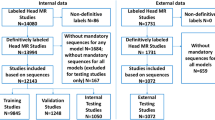Abstract
This article gives a detailed description of the techniques developed by the authors for primary and deep processing of magnetic-resonance imaging that are aimed at detecting areas of ischemic lesion in the rat brain. The tools include the techniques for bringing MRI images of different samples to the normalized form (size, shape, and brightness). Another set of tools is associated with the detection of anomalies based on T2 and MDC images using artificial neural networks and specific metrics. It is assumed that the created algorithms and programs will be part of the developed research software system that is oriented to support decision making by medical researchers.
Similar content being viewed by others
References
NITRC: Robust Brain Extraction (ROBEX): Tool/Resource Info. http://www.nitrc.org/projects/robex. Cited July 26, 2016.
BET–FslWiki. http://fsl.fmrib.ox.ac.uk/fsl/fslwiki/BET. Cited July 26, 2016.
NiftySeg-TIG. http://cmictig.cs.ucl.ac.uk/wiki/index.php/NiftySeg. Cited July 26, 2016.
Cabezas, M., Oliver, A., Llado, X., Freixenet, J., and Cuadra, M.B., A review of atlas-based segmentation for magnetic resonance brain images, Comput. Methods Progr. Biomed., 2011, no. 12, pp. 314–355.
Wei Huang, Automatic affine and elastic registration strategies for multi-dimensional medical images, A Dissertation in Partial Fulfillment of the Requirements for the Degree of Doctor of Philosophy, Worcester Polytechnic Institute, 2007.
Khachumov, M.V., Algorithms of integer arithmetic in problems of calculating trajectory motion, Sbornik nauchnykh trudov II Vserossiiskogo nauchno-prakticheskogo seminara “Bespilotnye transportnye sredstva elementami iskusstvennogo intellekta” (BTS-II-2015) (8–9 oktyabrya 2015 g. (Proc. II All-Russ. Sci. Pract. Seminar Unmanned Vehicles with Artificial Intelligence Elements (BTS-II-2015) (October 8–9, 2015, St. Petersburg)), St. Petersburg, 2015, pp. 130–135.
Braccini, C., Cocurullo, F., and Lavagetto, F., A fast algorithm for high quality vector quantization codebook design, Proc. 8th International Conference on Image Analysis and Processing, London: Springer-Verlag, 1995, pp. 643–648.
Abbadi, N.K., Dahir, N.S., and Alkareem, Z.A., Skin texture recognition using neural networks, Proc. Int’l Arab Conf. on Information Technology, 2008, pp. 1–4.
Haralick, R.M., Shanmugam, K., and Dinstein, I., Textural features for image classification, IEEE Trans. Syst. Man Cybern., 1973, vol. 3, pp. 610–621.
Amel'kin, S.A., Zakharov, A.V., and Khachumov, V.M., The generalized distance of Euclid-Mahalanobis and its properties, Inf. Tekhnol. Vychisl. Sist., 2006, no. 4, pp. 40–44.
Jones, D.K., Diffusion MRI: Theory, Methods, and Applications, New York: Oxford University Press, 2011.
Talalaev, A.A., Tishchenko, I.P., Fralenko, V.P., and Khachumov, V.M., Analysis of the efficiency of applying artificial neuron networks for solving recognition, compression, and prediction problems, Sci. Tech. Inf. Process., 2011, vol. 38, no. 5, pp. 313–321.
Khachumov, M.V., Application of artificial neural networks for the automatic classification of the degree of disease, Sbornik nauchnykh trudov po materialam III Mezhdunarodnoi nauchno-prakticheskoi konferentsii “Teoreticheskie i prikladnye aspekty sovremennoi nauki” (Belgorod, 30 sentyabrya 2014) (Proc. III Int. Sci. Pract. Conf. Theoretical and Applied Aspects of Modern Science (Belgorod, September 30, 2014)), 2014, part 1, pp. 203–208.
Molodchenkov, A.I., Fralenko, V.P., and Khachumov, V.M., Classification of severity of the disease on the basis of artificial neural networks, Vestn. RUDN, Ser. Mat. Inf. Fiz., 2014, no. 2, pp. 150–156.
LeCun, Y., Bengio, Y., and Hinton, G., Deep learning, Nature, 2015, vol. 521, no. 7553, pp. 436–444.
Maxout Networks. http://colinraffel.com/wiki/maxout_ networks. Cited July 26, 2016.
Srivastava, N., Hinton, G., Krizhevsky, A., Sutskever, I., and Salakhutdinov, R., Dropout: A Simple Way to Prevent Neural Networks from Overfitting, 2014. www.cs.toronto.edu/~hinton/absps/JMLRdropout.pdf. Cited July 26, 2016.
GitHub–milakov/nnForge: Convolutional neural networks C++ framework with CPU and GPU (CUDA) backends. https://github.com/milakov/nnForge. Cited July 26, 2016.
Lebedev, A.S., Fralenko, V.P., Chen, G.S., and Chzhan, G.L., Experimental study of the problem of searching for complex rigid objects in the space images processing system PS NSKiD, Sovrem. Probl. Nauki Obraz., 2015, no. 1. http://www.science-education. ru/pdf/2015/1/1194.pdf. Cited July 26, 2016.
Fralenko, V.P., Suvorov, R.E., Ovcharenko, R.I., and Tikhomirov, I.A., Automatic classification of images in problems of content filtering, Inf. Tekhnol. Vychisl. Sist., 2015, no. 3, pp. 3–11.
Agronik, A.Yu. and Fralenko, V.P., Library of algorithms for high-performance data processing from the technical vision system of an unmanned aerial vehicle, Progr. Sist.: Teor. Prilozh., 2016, no. 2, pp. 61–71.
Ciresan, D.C., Meier, U., Masci, J., Gambardella, L.M., and Schmidhuber, J., Flexible, high performance convolutional neural networks for image classification, International Joint Conference on Artificial Intelligence, 2011, pp. 1237–1242.
Author information
Authors and Affiliations
Corresponding author
Additional information
Original Russian Text © V.P. Fralenko, M.V. Khachumov, M.V. Shustova, 2016, published in Iskusstvennyi Intellekt i Prinyatie Reshenii, 2016, No. 4, pp. 27–37.
About this article
Cite this article
Fralenko, V.P., Khachumov, M.V. & Shustova, M.V. Tools for Automatically Finding and Visualizing Interest Areas in MRI Data to Support Decision Making by Medical Researchers. Sci. Tech. Inf. Proc. 44, 397–405 (2017). https://doi.org/10.3103/S0147688217060053
Published:
Issue Date:
DOI: https://doi.org/10.3103/S0147688217060053




